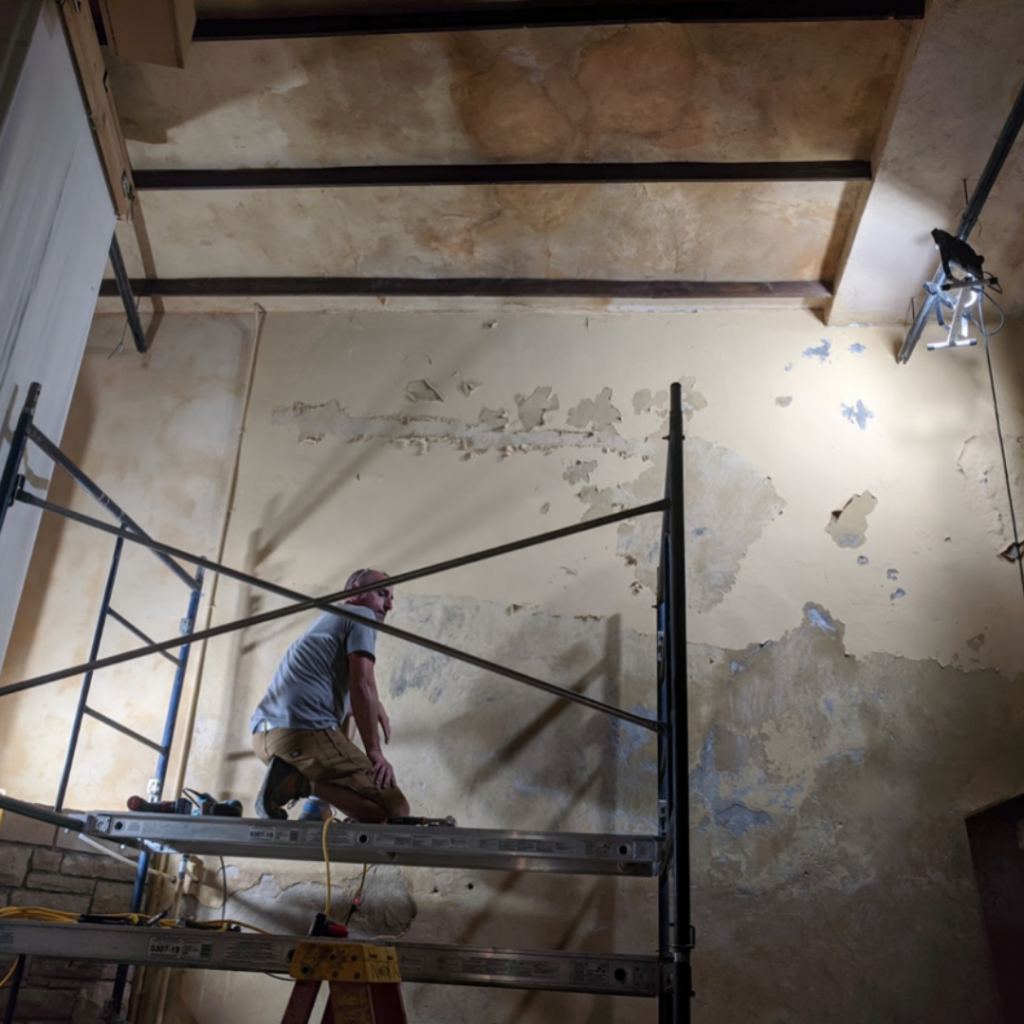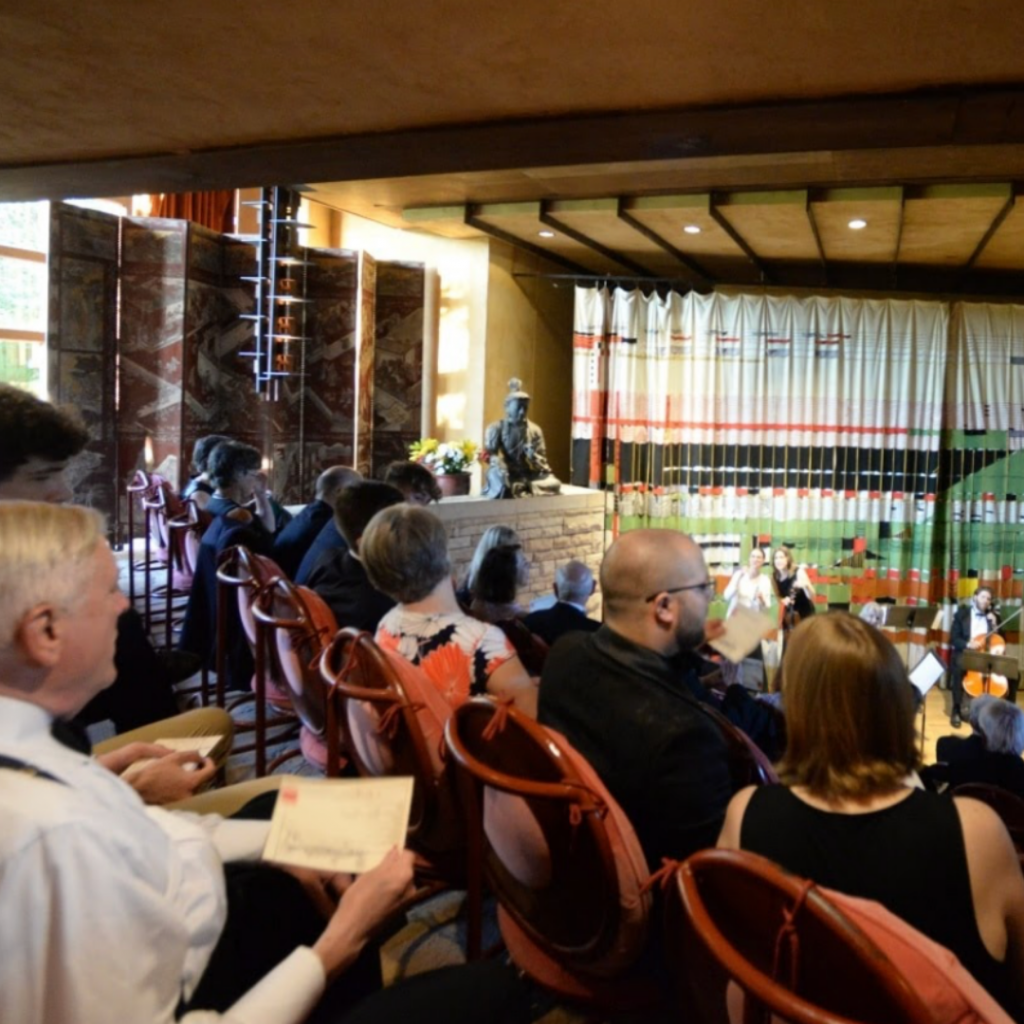ONLINE ORDERS MADE DECEMBER 31- JANUARY 8 WILL BE PROCESSED ON JANUARY 9
“Performances at Taliesin have always contributed significantly to its life. They interrupt the routine of mundane living with focused preparation, presentation, and participation. Hillside Theater did not displace the music, talks, and dramatic readings that took place in the magical living room at the Taliesin house, but it was the place where Wright invited the world beyond Taliesin to share in its creative life.”—Sidney K. Robinson, Author, Architect and former Emeritus Educator at Taliesin School of Architecture ¹
With the start of the Fellowship in 1932, the Hillside Theater transitioned from a multipurpose room, complete with a small stage and suspended running track, to a playhouse dedicated to entertainment.² On Sundays, Wright played movies for the public, and 50 cents covered both admission and coffee by the fire. From its first iterations to the 1955 structure that stands today, the theater has been a place of community convening and shared appreciation for the arts.³ The Hillside Theater Restoration Project was announced in 2018 following funding from The National Park Service. The Frank Lloyd Wright Foundation, in collaboration with Taliesin Preservation, worked with local and national foundations, corporations, and private donors to provide funds to match the Save America’s Treasures grant awarded for this $867,000 project.⁴ Following extensive planning, preservation was divided into three phases: elimination of water infiltration, rehabilitation of the basement, and restoration of the Hillside Theater. In 2020, the Foundation’s preservation team, Adam Charles, Construction and Maintenance Manager; Kyle Dockery, Collections Coordinator; and Ryan Hewson, the Director of Preservation at Taliesin, discussed ongoing efforts to redirect water away from the building and the initial stabilization plans for the theater’s lower level.⁵ Now, the team is entering the final phases of the project.
 |
 |
 |
| Original Sign on Display in the Theater | 2020 Taliesin Talk | Theater During Restoration |
Since installing exterior drainage systems to redirect stormwater away from the building, the team has fitted interior drainage systems. A sump pump and dimple board along exterior masonry walls further ensure the rehabilitated basement stays dry.⁶ In recent weeks, they worked with a contractor to pour a pair of new concrete floors in Hillside’s basement, one below the theater stage and one backstage. By replacing partial slabs and exposed segments with full concrete flooring, the intervention has reclaimed considerable square footage. With help from Southwest Wisconsin Technical College volunteers, the team has also removed the original stage flooring, de-nailed all of the salvageable oak boards, and prepared them for re-installation.⁷ The next phase of this project involves reinstalling the original stage flooring according to its original angled orientation, in alignment with the tracks of the beloved curtain overhead. A new HVAC system will run through a built-out wall that will act as a chase-way, providing ease of access for future repairs while increasing the amount of usable space in the lower level. While it does not create the climate-controlled environment that you might see in a museum, the new HVAC system will create a relative humidity band, providing fewer peaks and increased comfort levels for guests and objects, while extending seasonal use.
 |
 |
 |
| Volunteers from Southwest Tech | Concrete Pouring | Dimple Board in the Basement |
Extreme care has gone into each decision with a respect for former processes. However, as techniques develop and methods improve, structural requirements change. Previous repairs in the basement, for example, utilized localized solutions, like sistering or shims, support mechanisms to stabilize the existing structure. The preservation team has now constructed a framework for the basement that also supports the floor of the dining room above. This will ensure the structural stability of both spaces without visibly altering the historic space overhead.
“It’s humbling to see old techniques and people learning, and the efforts to keep things up”
—Ryan Hewson, Director of Preservation at Taliesin, Frank Lloyd Wright Foundation.
Preserving this work, not only means maintaining significant architectural features, but keeping the stories of Taliesin’s craftsmen alive. Throughout the site are several moments that encapsulate the culture of experimentation at the heart of Taliesin. Wright encouraged Fellows to embrace learning by doing and considerable attention has gone into maintaining Hillside’s historic core. During the course of the project, the preservation team has been careful to work around the existing masonry in the foyer and preserve the stone pillars in the basement. In the foyer, guests can see examples of pillow-faced stone executed by the stonemasons who first built Hillside adjacent to later attempts by apprentices to emulate it, visible moments of the apprentices learning by doing.
Throughout the restoration process, decisions have been guided by a desire to maintain the Theater’s historic role as a center for creativity. The preservation team is restoring this valuable piece of the community’s history, so it can continue to create a lasting impact for generations to come.
“We’re interested in filling these spaces with life, as opposed to imagining them. To really experience them is to be in them.”—Ryan Hewson, Director of Preservation at Taliesin, Frank Lloyd Wright Foundation
Audience members will notice repaired plasterwork and wood surfaces, improved climate control, and an ADA-accessible restroom. New lighting and camera systems allow guests to enjoy a variety of performances virtually. Visitors will still find notable marks of historical importance, such as Wright’s boot and cane marks in the grout outside the entrance. Many of the changes in the Theater, however, will not be easily noticeable, the desired effect of the completed restoration.
 |
 |
 |
| Sandstone Pillowing in the Foyer | Plasterwork | Theater During a Performance
Photo: Mark Hertzberg |
Performers will enjoy new green room spaces, an accessible backstage bathroom, and increased stage functionality with continuous flooring that creates a seamless transition to backstage areas. The improvements create an inviting and inclusive space to attract international, regional, and local talent from multiple disciplines to this historical venue. Future programming will continue Wright’s vision of the Theater through lectures, symposia, and multicultural performances in a variety of art forms.
In this renewed space, audience and performers will experience an “escape from everyday life,” a “captivating energy between performer, audience and architectural setting,” and “a sense of bonding and togetherness.” —Caroline Hamblen- Director of Programs at Taliesin
The Hillside Theater Restoration marks a shift in restoration efforts at Taliesin towards larger projects. Following this, certain restoration efforts on the estate will be large and long-term. This emphasizes the importance of day-to-day preservation and custodial care to catch potential problems before they arise. While the preservation and rehabilitation processes at Hillside have come with their fair share of challenges, by working together to solve problems, the team has ensured a lasting structure that maintains its historical integrity.
Robinson, Sidney. “The Important Role of Hillside Theater.” World Monuments Fund, July 1, 2014. https://www.wmf.org/blog/important-role-hillside-theater-taliesin.
Photos from the Playhouse’s opening weekend in 1933 depict the converted gymnasium, complete with a balcony and projection box. A foyer was added in 1948.
In April 1952, a brush fire burned Hillside, destroying most of the original playhouse, except for the foyer. Wright designed the structure shortly after, and construction started the following year. The new theater was completed in 1955.
Partially funded by the Save America’s Treasures program of the Historic Preservation Fund, National Park Service, Department of the Interior. Any opinions, findings, and conclusions or recommendations expressed in this material do not constitute endorsement or necessarily reflect the views of the Department of the Interior or U.S. Government.
“Taliesin Talks: Behind the Restoration: Hillside Theatre at Taliesin.” Frank Lloyd Wright Foundation, September 23, 2020. https://franklloydwright.org/event/taliesin-talks-hillside-theatre-restoration/.
Dimple board is installed so that if water does come through the wall, it will go down the plastic board to a drainage tile that connects to the sump crock. This is used in the event of a failure in the exterior system.
Several of the boards were replaced due to severe water damage. The reclaimed flooring will be installed on new joists and sheathing, then sanded and refinished.